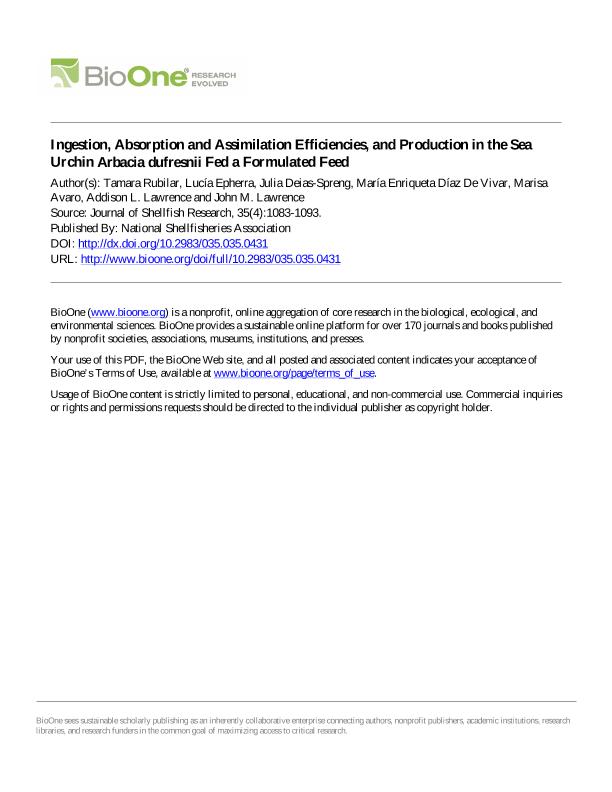Artículo
Ingestion, Absorption and Assimilation Efficiencies, and Production in the Sea Urchin Arbacia dufresnii Fed a Formulated Feed
Rubilar Panasiuk, Cynthia Tamara ; Epherra, Lucía
; Epherra, Lucía ; Deias Spreng, Julia; Díaz de Vivar, María Enriqueta Adela; Avaro, Marisa Gladis; Lawrence, Addison L.; Lawrence, John M.
; Deias Spreng, Julia; Díaz de Vivar, María Enriqueta Adela; Avaro, Marisa Gladis; Lawrence, Addison L.; Lawrence, John M.
 ; Epherra, Lucía
; Epherra, Lucía ; Deias Spreng, Julia; Díaz de Vivar, María Enriqueta Adela; Avaro, Marisa Gladis; Lawrence, Addison L.; Lawrence, John M.
; Deias Spreng, Julia; Díaz de Vivar, María Enriqueta Adela; Avaro, Marisa Gladis; Lawrence, Addison L.; Lawrence, John M.
Fecha de publicación:
12/2016
Editorial:
National Shellfisheries Association
Revista:
Journal Of Shellfish Research
ISSN:
0730-8000
Idioma:
Inglés
Tipo de recurso:
Artículo publicado
Clasificación temática:
Resumen
Sea urchins have been used as a source of food from prehistoric times and as a research animal model since the 19th century. They presently are harvested in many parts of the world. In Argentina, sea urchins have been studied only from biological perspectives. Of the 14 species of sea urchins found off the coast of Argentina, Arbacia dufresnii is the most abundant. It is an omnivorous species that exists in dense populations in Nuevo Gulf. Biomass production in sea urchins, especially gonad yield, is related to food quantity and quality. In the field, A. dufresnii has a small size and low gonad biomass and gamete production. Therefore to test the hypothesis that a high-quality formulated food would produce more biomass and gonad yield than that found in the sea urchins from a natural population, sea urchins were reared in a laboratory aquaculture system for 8 wk in autumn when gametogenesis occurs. In April, 30 sea urchins were collected and dissected to establish the initial condition (Baseline). Another 32 sea urchins were collected in April and maintained until June in aquaria at constant temperature and salinity and fed a formulated feed (Fed). At the conclusion of the experiment, 30 sea urchins were collected from the field population in June (Field) to establish the population condition in the Field and for comparison with the Fed sea urchins. Fed sea urchins had a 20% greater gain in weight resulting from an increase in both somatic and gonadal tissue beyond that of the field population. All organs increased in weight in females and all organs except the lantern in males. The absorption efficiency in Fed sea urchins was over 80%. Fed sea urchin had organic biomass production higher than Field sea urchins. Differences were found in the gonad cellular composition: Fed females had a unimodal oocyte size-frequency distribution, in contrast to a multimodal distribution in Field females. Fed males had fewer mature gametes than Field males. Both testes and ovaries had more nutritive phagocytes in Fed sea urchins than in Field sea urchins. Proximate composition of gonads, however, was similar in Fed and Field sea urchins. Fed individuals showed a remarkable increase in biomass production. The biochemical and cellular composition of the gonads reflected this. This indicates that A. dufresnii fed a highly nutritional food is able to assimilate nutrients with high efficiency and produce an increased gonad yield.
Palabras clave:
Arbacia Dufresnii
,
Artificial Fed
,
Echinoidea
,
Production
Archivos asociados
Licencia
Identificadores
Colecciones
Articulos(CESIMAR)
Articulos de CENTRO PARA EL ESTUDIO DE SISTEMAS MARINOS
Articulos de CENTRO PARA EL ESTUDIO DE SISTEMAS MARINOS
Articulos(IDEAUS)
Articulos de INSTITUTO DE DIVERSIDAD Y EVOLUCION AUSTRAL
Articulos de INSTITUTO DE DIVERSIDAD Y EVOLUCION AUSTRAL
Citación
Rubilar Panasiuk, Cynthia Tamara; Epherra, Lucía; Deias Spreng, Julia; Díaz de Vivar, María Enriqueta Adela; Avaro, Marisa Gladis; et al.; Ingestion, Absorption and Assimilation Efficiencies, and Production in the Sea Urchin Arbacia dufresnii Fed a Formulated Feed; National Shellfisheries Association; Journal Of Shellfish Research; 35; 4; 12-2016; 1083-1093
Compartir
Altmétricas



